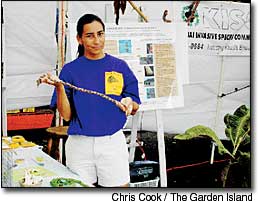Officials in the U.S. Department of Agriculture’s Animal and Plant Health Inspection Service-Wildlife Services division say cuts up to 50 percent are expected in the snake-containment inspections conducted at U.S. Department of Defense ports of exit on Guam as of
Officials in the U.S. Department of Agriculture’s Animal and Plant Health Inspection Service-Wildlife Services division say cuts up to 50 percent are expected in the snake-containment inspections conducted at U.S. Department of Defense ports of exit on Guam as of Oct. 1.
The brown tree snake devastated Guam’s native forests in the past, and there are fears that the snake might make its way to Kaua‘i. So far, no brown tree snakes — or signs that the snake is here — have been found.
Wildlife Services leaders employ 25 full-time snake trappers and nine canine handlers on Guam, to minimize the chance of brown tree snakes being accidentally transported off the island in commercial and military cargo, vehicles, and vessels.
The interdiction efforts at Guam’s Won Pat International Airport, Harmon Industrial Area, and Commercial Port are funded through the U.S. Department of Interior’s Office of Insular Affairs.
Funding for brown tree snake interdiction efforts at U.S. Department of Defense facilities, specifically Andersen Air Force Base and U.S. Navy Port Facilities in Apra Harbor, has not increased substantially since this program was established 11 years ago.
Some 6,000 brown tree snakes are removed annually from Guam’s five ports of exit, and nearly two-thirds of the snakes are removed from cargo facilities operated by the Air Force and the Navy.
Military operations on Guam are expected to grow due to expansion of Andersen Air force Base and U.S. Navy Port Facilities in Apra Harbor over the next few years.
“The military has a responsibility to ensure that they are not transporting this extremely damaging pest to all islands and countries receiving cargo and vessels from Guam,” said Christy Martin of the Hawaii Coordinating Group on Alien Pest Species in a press release. “The cost of USDA Wildlife Services efforts to keep snakes from transport should be considered a necessary part of operating on Guam.”
“The level of support for brown tree snake interdiction programs needs to be directly related to the volume of military and commercial traffic leaving Guam,” said Mindy Wilkinson, invasive species coordinator for the state Department of Land and Natural Resources in Honolulu. “If the level of support for brown tree snake interdiction is not increased, the state of Hawai‘i is at significant risk for the accidental introduction of brown tree snakes.”
Previous funding shortfalls for the Wildlife Services brown tree snake interdiction program on Guam have been circumvented by additional funding received through a variety of other sources.
The brown tree snake was probably introduced to Guam in materials moved by the military during the late 1940s. The snake has caused, and continues to cause, significant economic, ecological, and human health impacts to the island, including the extinction of nine of 13 native forest-bird species on Guam. The brown tree snake causes frequent electrical power outages, and is a concern for human health and safety. Snakes currently occur at high densities on Guam, and there is a significant risk that these snakes will be transported off Guam in military or civilian cargo; some of the cargo could reach Kaua‘i through military transport to the Pacific Missile Range Facility or Lihu‘e Airport, or at seaports.
Potential economic impact to Hawai‘i could be well over $400 million annually if the same devastation that hit Guam occurred in the Hawaiian islands.
Since 1993, USDA-Wildlife Services program officers have managed a successful containment program on Guam to prevent the inadvertent spread of the brown tree snake via cargo traffic to other Pacific islands including Hawai‘i and Kaua‘i. Program officials operate some 3,000 brown tree snake traps, conducts nightly spotlight searches for snakes climbing on harbor and airport fence lines, and use specially trained snake-detector dogs to search cargo and vessels departing from the island’s five major ports of exit.


